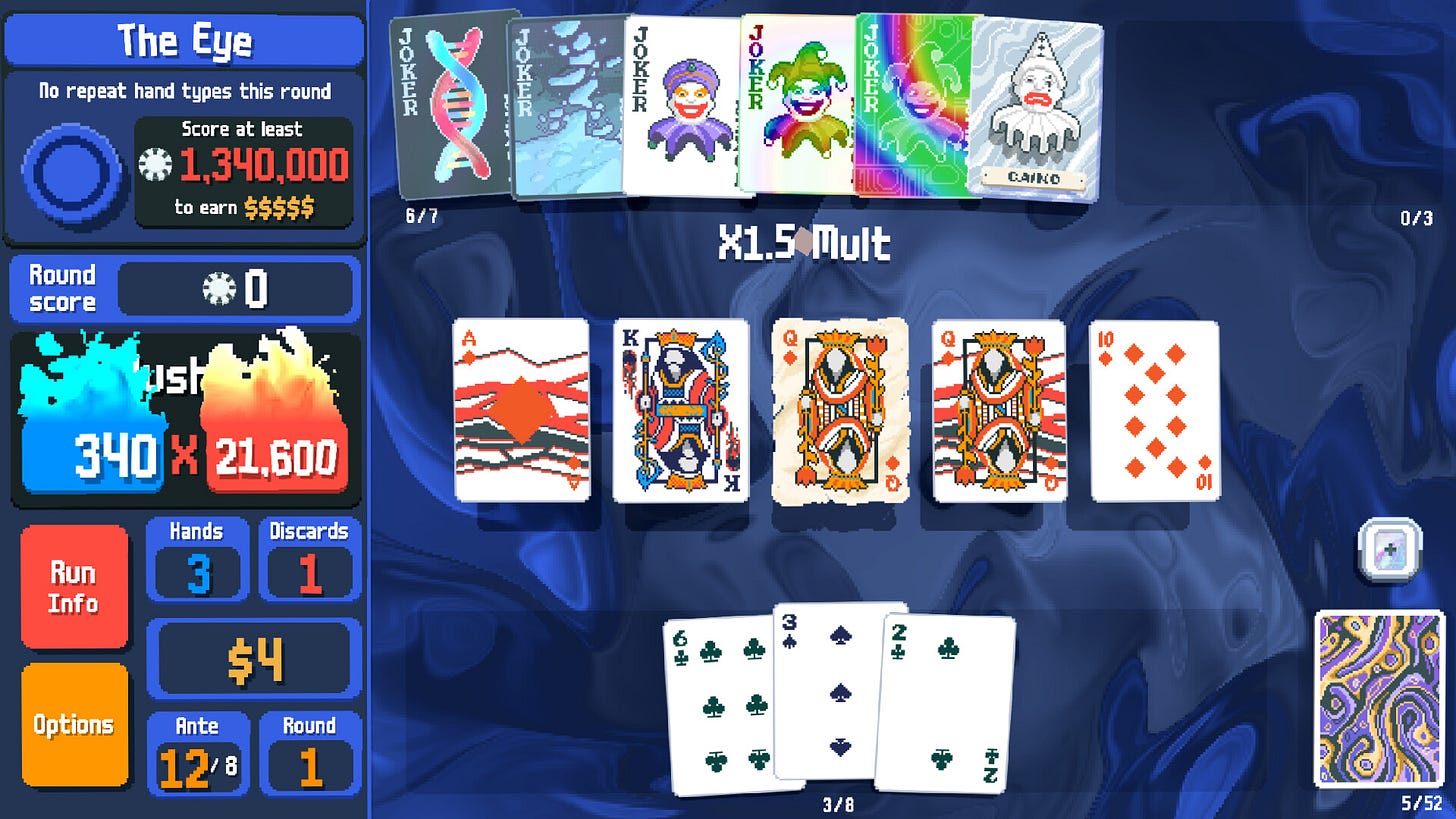The Word-of-Mouth Magic Behind Breakout Hits Like Balatro
LocalThunk says the streamer Dan Gheesling changed everything for Balatro. I asked Gheesling for his POV.
Hi to all the new readers: I’m Ryan Rigney and this is Push to Talk, a weekly newsletter about the art and business of video games. Lately I’ve been thinking about the role YouTubers play in helping players discover new games. This week’s post features a superstar streamer credited with helping break out last year’s biggest indie game.
It seemed like Balatro came out of nowhere.
Solo dev LocalThunk was an unknown quantity when he dropped his “Poker roguelike” on Steam last year. But it turned out to be one of the biggest breakout hits of the year—and maybe ever—selling over 5 million copies on Steam alone.
Mr. ‘Thunk is an intensely private person: his real name isn’t public, and he rarely participates in interviews. So it came as a surprise a few months ago when he published this incredibly detailed and beautifully written essay detailing his experience leading up to the release of the game.1
In the piece, LocalThunk describes how Balatro gained traction with players before its release. Nearly a year prior to launch, in fact, there was a massive inflection point.
The essay, titled “The Balatro Timeline,” breaks it down beat-by-beat:
In May 2023, the same month LocalThunk uploaded the first public Beta build of Balatro on Steam, he only had 48 wishlists on Steam.
By June 10th of that year, Balatro still only had 183 wishlists on Steam, but he had already been contacted by a scout for Playstack, which eventually became his publisher. (Shout out to Playstack for being insanely early to catch one of the best-selling digital card games ever.)
Between mid-June and July 2023, things accelerated very rapidly. First, LocalThunk writes, “Dan Gheesling plays Balatro on his stream. This is a massive streamer for my game (and a great guy!), and it starts making my wishlist numbers spike.”
Later, Gheesling introduced the game to another streamer, Northernlion. From here, interest in the game exploded. “By end of July, Balatro had 28,661 wishlists on Steam,” LocalThunk writes.
As work on the game progressed, player excitement only grew. By the end of October 2023 the game had 77,380 wishlists on Steam, and LocalThunk says the stress was beginning to get to him:
My sleep and my heart are getting worse. Every few nights I need to sleep sitting upright on the couch because sleeping while lying down kept getting interrupted by my heart. I stupidly thought that I couldn’t handle going to the doctor while dealing with all the dev and business stuff swirling around at the time. I felt totally overwhelmed.
—LocalThunk in The Balatro Timeline
The rest of the essay is a gripping read, as LocalThunk details how his mental and physical health deteriorated as hype for the game soared beyond all expectations and the game’s launch neared.
The pressure only increased as demand grew. By the time Balatro launched in February of 2024, it had exactly 208,401 wishlists on Steam. Even with those strong numbers, the game outperformed even the wildest expectations LocalThunk and his publishers had for it. How did it happen?
To me, the most intriguing part of this story came during that early massive spike in June/July 2023. In six weeks, the game went from 183 wishlists to nearly 30k. I’m a marketer at heart, so I can’t help but be enamored with inflection points—those magical moments when a basically flat line on a chart suddenly goes 📈.2
So I wondered: if Dan Gheesling’s video about Balatro (and his subsequent advocacy for it with other streamers) did indeed cause its inflection point, how did Gheesling hear about the game in the first place?
Death of the Inbox
I decided to hit up Gheesling directly. I was curious: Maybe LocalThunk had sent him a really clean email about the game?
This was not the case.
“I probably delete four to five emails a day that have a lot of emojis in the title and that say ‘Steam key attached,’” Gheesling told me. “It’s really been hard to find the hidden gems because there's just been this onslaught of games. It's really, really difficult now to penetrate an email box. I very rarely will play a game that's just sent in as a blind email.”
There are some exceptions to this, Gheesling says. It helps if developers include an animated GIF of their game in an email. He also notes that it’s rare to receive a message that’s been personalized in any way, as many developers use services to mass-distribute Steam keys to streamers. But even these tactics might not make a difference, he admits. “It's probably anywhere between 10 and 25 Steam keys a week, so I don't even look at them at this point, unfortunately.”
If it wasn’t pitched by LocalThunk, then how did Gheesling actually discover Balatro? Remember, when Gheesling first picked up the game, it was only available as a beta and had wishlists in the hundreds, not thousands.
“I have a community Discord,” Gheesling explains, “and there's a room in there where people drop game suggestions. I check out a lot of the recommendations from people within the community because they kind of understand what games do well on the channel and also games I enjoy playing.”
Balatro, Gheesling says, was one of these community recommendations.
Word-of-Mouth as the Foundational Layer
The most mysterious force in marketing is word-of-mouth growth.
You can run the most polished ads, the most clever influencer campaign, with the spiciest viral social media posts—and if you don’t get word-of-mouth growth, you will get nowhere. The size of your budget is worth jack-all if, ultimately, people don’t pick up what you’re putting down and move the message for you.
Conversely, you can be a complete rando with no budget whatsoever and 183 wishlists on Steam, and if your word-of-mouth is strong enough you can run a generational pre-launch campaign that sells 5 million copies. The difference is in the WoM.
One of the many questions we might ask about word-of-mouth is: How do I know if the thing I’m making is going to have it?
Earlier in LocalThunk’s blog, we get a hint.

In June of 2022, a very early stage of development, LocalThunk writes that he shared a copy of the game with some friends. A couple of months went by, and then one of those friends reached back out with “very high praise.” It was “unexpectedly high.”
He mentions that he has played the beta for dozens of hours.
In all my years of sharing projects with friends I had never received feedback like that. I couldn’t believe it, and it really pushed me over the edge to fully flesh out this idea. It was really great knowing that this game was actually being enjoyed by someone I know, and I wanted to prove to him, my other friends, my partner, my family, and myself that I could make something really fun and interesting.
—LocalThunk
It’s tempting for game devs to think of big streamers as being mere gatekeepers—as the first test that can make or break your game’s ability to reach players. But in truth, there is something more fundamental at play. It’s the ground beneath the streamers that enables them to hear about your game in the first place.
At that foundational layer, there is a question: Can your game make someone care enough to sing your praises?
That’s the first test.
And that’s it for this week.
If you really loved this article, spare some WoM and tell your friends to…
Over the next few weeks I’ll be publishing a series of pieces examining the game dev > YouTuber > player pipeline. This was part two.
Check out part one: How to Get YouTubers to Play Your Game.
If any of you complain about using an emoji in a sentence I swear I’ll do it again.









Ryan in the next interview: "Mr. Thunk, can I call you Local?" ;-)
Thanks Ryan for the credit! You deserve some bananas, especially after a gold stake run.